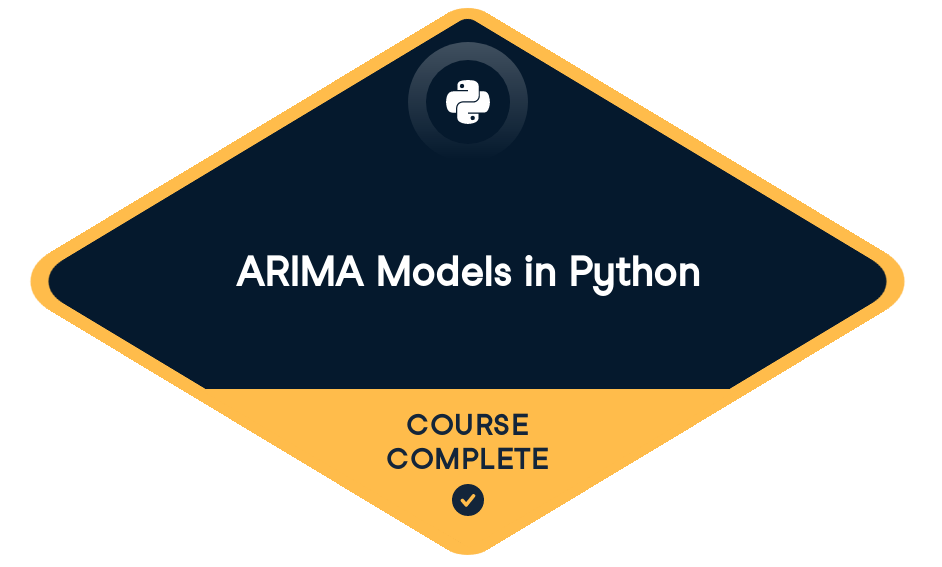
Loved by learners at thousands of companies
Course Description
Have you ever tried to predict the future? What lies ahead is a mystery that is usually only solved by waiting. In this course, you can stop waiting and dive into the world of time series modeling using ARIMA models in Python to forecast the future.
Making these concepts easy to grasp and apply, you’ll uncover generating one-step-ahead predictions, dynamic forecasts, and fitting ARIMA models directly to your data.
This final project ties everything together, giving you a comprehensive understanding of ARIMA modeling.
Time series data
Start by learning the basics of time series data, including the concept of stationarity—crucial for working with ARMA models. You'll learn how to test for stationarity both visually and statistically, generate ARMA data, and fit ARMA models to get a solid foundation.Statsmodels package
As you progress, explore the powerful Statsmodels package for fitting ARMA, ARIMA, and ARMAX models. You'll get hands-on experience using your models to predict future values like stock prices.Making these concepts easy to grasp and apply, you’ll uncover generating one-step-ahead predictions, dynamic forecasts, and fitting ARIMA models directly to your data.
ACF and PACF plots
One of the highlights is learning how to choose the best model using ACF and PACF plots to identify promising model orders. You'll learn about criteria like AIC and BIC for model selection and diagnostics, helping you refine your models to perfection.SARIMA models
The course wraps up with seasonal ARIMA (SARIMA) models, perfect for handling data with seasonal patterns. You'll learn to decompose time series data into seasonal and non-seasonal components and apply your ARIMA skills in a global forecast challenge.This final project ties everything together, giving you a comprehensive understanding of ARIMA modeling.
Training 2 or more people?
Get your team access to the full DataCamp platform, including all the features.- 1
ARMA Models
FreeDive straight in and learn about the most important properties of time series. You'll learn about stationarity and how this is important for ARMA models. You'll learn how to test for stationarity by eye and with a standard statistical test. Finally, you'll learn the basic structure of ARMA models and use this to generate some ARMA data and fit an ARMA model.
Intro to time series and stationarity50 xpExploration100 xpTrain-test splits100 xpIs it stationary100 xpMaking time series stationary50 xpAugmented Dicky-Fuller100 xpTaking the difference100 xpOther tranforms100 xpIntro to AR, MA and ARMA models50 xpModel order100 xpGenerating ARMA data100 xpFitting Prelude100 xp - 2
Fitting the Future
What lies ahead in this chapter is you predicting what lies ahead in your data. You'll learn how to use the elegant statsmodels package to fit ARMA, ARIMA and ARMAX models. Then you'll use your models to predict the uncertain future of stock prices!
Fitting time series models50 xpFitting AR and MA models100 xpFitting an ARMA model100 xpFitting an ARMAX model100 xpForecasting50 xpGenerating one-step-ahead predictions100 xpPlotting one-step-ahead predictions100 xpGenerating dynamic forecasts100 xpPlotting dynamic forecasts100 xpIntro to ARIMA models50 xpDifferencing and fitting ARMA100 xpUnrolling ARMA forecast100 xpFitting an ARIMA model100 xpChoosing ARIMA model50 xp - 3
The Best of the Best Models
In this chapter, you will become a modeler of discerning taste. You'll learn how to identify promising model orders from the data itself, then, once the most promising models have been trained, you'll learn how to choose the best model from this fitted selection. You'll also learn a great framework for structuring your time series projects.
Intro to ACF and PACF50 xpAR or MA100 xpOrder of earthquakes100 xpIntro to AIC and BIC50 xpSearching over model order100 xpChoosing order with AIC and BIC100 xpAIC and BIC vs ACF and PACF100 xpModel diagnostics50 xpMean absolute error100 xpDiagnostic summary statistics100 xpPlot diagnostics100 xpBox-Jenkins method50 xpIdentification100 xpIdentification II100 xpEstimation100 xpDiagnostics100 xp - 4
Seasonal ARIMA Models
In this final chapter, you'll learn how to use seasonal ARIMA models to fit more complex data. You'll learn how to decompose this data into seasonal and non-seasonal parts and then you'll get the chance to utilize all your ARIMA tools on one last global forecast challenge.
Seasonal time series50 xpSeasonal decompose100 xpSeasonal ACF and PACF100 xpSARIMA models50 xpFitting SARIMA models100 xpChoosing SARIMA order100 xpSARIMA vs ARIMA forecasts100 xpAutomation and saving50 xpAutomated model selection100 xpSaving and updating models100 xpSARIMA and Box-Jenkins50 xpMultiplicative vs additive seasonality50 xpSARIMA model diagnostics100 xpSARIMA forecast100 xpCongratulations!50 xp
Training 2 or more people?
Get your team access to the full DataCamp platform, including all the features.datasets
US Monthly Candy ProductionMonthly Record of CO2Amazon Daily Closing Stock PriceMonthly Milk ProductionYearly Earthquakescollaborators


prerequisites
Supervised Learning with scikit-learnClimate Informatics Researcher
James is a PhD researcher at the University of Edinburgh, where he tutors computing, machine learning, data analysis, and statistical physics. His research involves using and developing machine learning algorithms to extract space-time patterns from climate records and climate models. He has held visiting researcher roles, working on planet-scale data analysis and modeling, at the University of Oxford and Queen's University Belfast and has a masters in physics where he specialized in quantum simulation. In a previous life, he was employed as a data scientist in the insurance sector. When not several indents deep in Python, he performs improvised comedy.
Join over 17 million learners and start ARIMA Models in Python today!
Create Your Free Account
or
By continuing, you accept our Terms of Use, our Privacy Policy and that your data is stored in the USA.